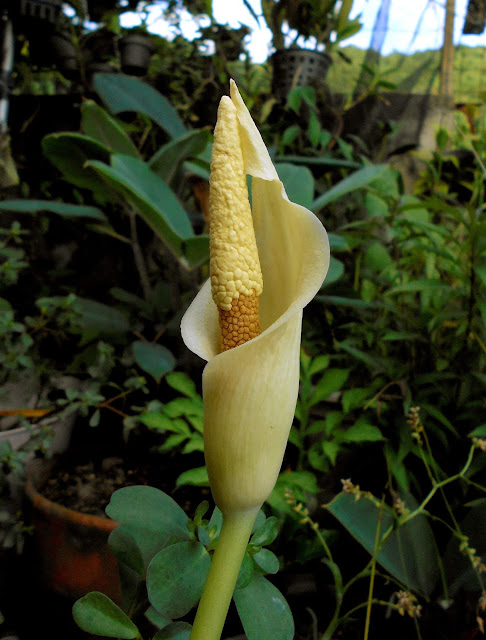Amorphophallus salmoneus x A. macrophyllus 'Bluto': Will you or will you not?
Today, the male flowers of Amorphophallus salmoneus began shedding pollen, coinciding with the receptivity of the female flowers of one of my many A. macrophyllus 'Bluto'. You know what that means.
Frankly, I am not sure if this endeavor will 'take'. I always felt that the former genus Pseudodracontium (of which macrophyllus is a member of) is sufficiently distinct from Amorphophallus to stand as its own genus, which is another way of saying that there is a possibility that I just wasted my time. Of course, plants from two different genera can be artificially crossed, but there are many cases when they just won't. However, I am prepared to be surprised. And I want to be wrong.
For those wondering why I think Pseudodracontium might be distinct from Amorphophallus, the answer lies in their more verrucate appendices AND the fact that contrary to most Amorphophallus, the inflorescences are synanthous. What the latter means is that the peduncles appear before the newly emerged vegetative growth expands the leaf. Of course, there are some Amorphophallus species where the blooms appear together with the leaves (e.g. A. ongsakulii), but these do not have the verrucate appendices of Pseudodracontium.
 |
| "And now I'm pollen, pollen. Catch me if you can..." |
Here below is the exposed female floral zone of A. m. 'Bluto'. Maybe we'll see something interesting forming in a matter of days. Or maybe we won't.






Please update us if you are successful!
ReplyDeleteI certainly will!
DeleteAny word on progress?
ReplyDeleteUnfortunately (or expectedly, I should say), the whole thing collapsed. If there is a hybrid, natural or otherwise, resulting from an Amorphophallus x Pseudodracontium cross then I'd really be interested to see it. Because apparently, Pseudodracontium may be different enough from Amorphophallus to permit hybridization.
Delete